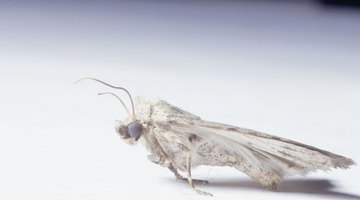How to Repair Moth Damaged Clothing
Clothes moths, or miller moths, are tiny brown moths that take up residence in closets and other dark areas of your home. They often go unnoticed until you find small holes in your favorite wool sweaters or blankets.

The moths themselves aren't responsible for the destruction--it is their larvae, which feed off of wool, silk, hair, felt, fur and other similar materials. Moth-eaten clothing can be difficult to fix, but is oftentimes salvageable with a little sewing talent or ingenuity.
-
Determine the extent of the damage and whether repairing the garment makes sense in terms of the clothing's value. Some things to consider prior to repairing the moth-damaged clothing include: how much you paid for the item, how much you would miss it and whether repairing it would be less expensive than replacing it.
-
Find professional clothing repair shops to get quotes on having the item repaired or, if you have sewing skills, you may be able to make these repairs yourself. At a repair shop, the cost will be determined by the size and quantity of the holes that need to be repaired, as well as the type of fabric and how long it will take to repair the holes. A French reweave takes threads from elsewhere on the garment to repair small holes. When done correctly, a French reweave is almost impossible to detect. For larger holes, a piece reweaving is often necessary. This technique requires a piece of fabric taken from a hemline, facing or other indistinguishable area of the fabric to create a patch that can be sewed into the moth-eaten areas of the clothing. A single hole will often cost about $30 to fix, while a garment with multiple holes could cost upwards of $70.
-
Ask to see samples of the company's work prior to dropping your moth-damaged garments off for repair. You should also ask for a list of references so that you can contact prior customers regarding their experiences.
-
Use your creativity to think of ways to hide the damage if you determine that having the clothing professionally repaired is too expensive. Depending on where the hole is located, a decorative scarf, pin, patch or button may hide it nicely and make it possible for you to wear your moth-damaged clothing without paying to have it fixed.
The Drip Cap
- Clothes moths, or miller moths, are tiny brown moths that take up residence in closets and other dark areas of your home.
- They often go unnoticed until you find small holes in your favorite wool sweaters or blankets.
- For larger holes, a piece reweaving is often necessary.
- Depending on where the hole is located, a decorative scarf, pin, patch or button may hide it nicely and make it possible for you to wear your moth-damaged clothing without paying to have it fixed.
References
Writer Bio
Lynn Burbeck is a professional writer with over five years of experience writing for the Web. She has published numerous articles for print and online media including "Grit" Magazine. Burbeck holds a B.A. in journalism and political science.
Photo Credits
- David De Lossy/Photodisc/Getty Images
- David De Lossy/Photodisc/Getty Images
More Articles



